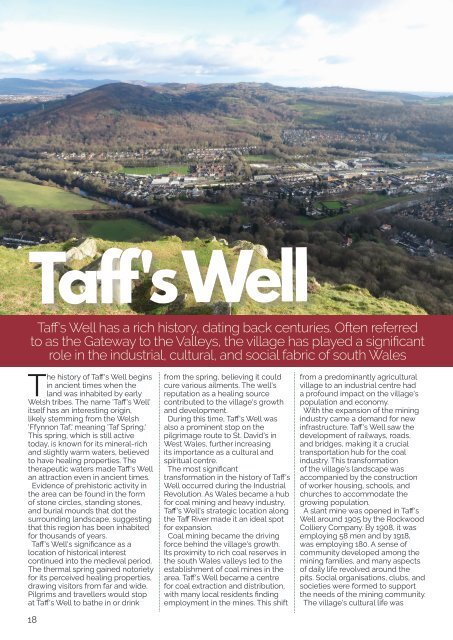Whitchurch and Llandaff Living Issue 68
Issue 68 of the award-winning Whitchurch and Llandaff Living magazine.
Issue 68 of the award-winning Whitchurch and Llandaff Living magazine.
Create successful ePaper yourself
Turn your PDF publications into a flip-book with our unique Google optimized e-Paper software.
Taff's Well<br />
Taff's Well has a rich history, dating back centuries. Often referred<br />
to as the Gateway to the Valleys, the village has played a significant<br />
role in the industrial, cultural, <strong>and</strong> social fabric of south Wales<br />
The history of Taff's Well begins<br />
in ancient times when the<br />
l<strong>and</strong> was inhabited by early<br />
Welsh tribes. The name 'Taff's Well'<br />
itself has an interesting origin,<br />
likely stemming from the Welsh<br />
'Ffynnon Taf,' meaning 'Taf Spring.'<br />
This spring, which is still active<br />
today, is known for its mineral-rich<br />
<strong>and</strong> slightly warm waters, believed<br />
to have healing properties. The<br />
therapeutic waters made Taff's Well<br />
an attraction even in ancient times.<br />
Evidence of prehistoric activity in<br />
the area can be found in the form<br />
of stone circles, st<strong>and</strong>ing stones,<br />
<strong>and</strong> burial mounds that dot the<br />
surrounding l<strong>and</strong>scape, suggesting<br />
that this region has been inhabited<br />
for thous<strong>and</strong>s of years.<br />
Taff's Well's significance as a<br />
location of historical interest<br />
continued into the medieval period.<br />
The thermal spring gained notoriety<br />
for its perceived healing properties,<br />
drawing visitors from far <strong>and</strong> wide.<br />
Pilgrims <strong>and</strong> travellers would stop<br />
at Taff's Well to bathe in or drink<br />
18<br />
from the spring, believing it could<br />
cure various ailments. The well's<br />
reputation as a healing source<br />
contributed to the village's growth<br />
<strong>and</strong> development.<br />
During this time, Taff's Well was<br />
also a prominent stop on the<br />
pilgrimage route to St. David's in<br />
West Wales, further increasing<br />
its importance as a cultural <strong>and</strong><br />
spiritual centre.<br />
The most significant<br />
transformation in the history of Taff's<br />
Well occurred during the Industrial<br />
Revolution. As Wales became a hub<br />
for coal mining <strong>and</strong> heavy industry,<br />
Taff's Well's strategic location along<br />
the Taff River made it an ideal spot<br />
for expansion.<br />
Coal mining became the driving<br />
force behind the village's growth.<br />
Its proximity to rich coal reserves in<br />
the south Wales valleys led to the<br />
establishment of coal mines in the<br />
area. Taff's Well became a centre<br />
for coal extraction <strong>and</strong> distribution,<br />
with many local residents finding<br />
employment in the mines. This shift<br />
from a predominantly agricultural<br />
village to an industrial centre had<br />
a profound impact on the village's<br />
population <strong>and</strong> economy.<br />
With the expansion of the mining<br />
industry came a dem<strong>and</strong> for new<br />
infrastructure. Taff's Well saw the<br />
development of railways, roads,<br />
<strong>and</strong> bridges, making it a crucial<br />
transportation hub for the coal<br />
industry. This transformation<br />
of the village's l<strong>and</strong>scape was<br />
accompanied by the construction<br />
of worker housing, schools, <strong>and</strong><br />
churches to accommodate the<br />
growing population.<br />
A slant mine was opened in Taff's<br />
Well around 1905 by the Rockwood<br />
Colliery Company. By 1908, it was<br />
employing 58 men <strong>and</strong> by 1918,<br />
was employing 180. A sense of<br />
community developed among the<br />
mining families, <strong>and</strong> many aspects<br />
of daily life revolved around the<br />
pits. Social organisations, clubs, <strong>and</strong><br />
societies were formed to support<br />
the needs of the mining community.<br />
The village's cultural life was

















